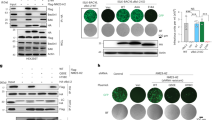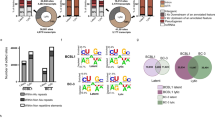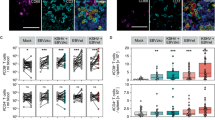Abstract
Kaposi sarcoma herpesvirus (KSHV), also known as human herpesvirus 8, is the causative agent of Kaposi sarcoma; this malignant angiosarcoma is usually treated with conventional antitumor agents that can control disease evolution, but do not clear the latent KSHV episome that binds to cellular DNA. Some commercial antibacterial sulfonamides were tested for the ability to suppress latent KSHV. Quantitative PCR (qPCR) and cytofluorometry assays were used for detecting both viral DNA and the latency factor LANA (latency-associated nuclear antigen) in BC3 cells, respectively. The capacity of sulfonamides to impair MDM2–p53 complex formation was detected by an enzyme-linked immunosorbent assay method. The analysis of variance was performed according to one-way analysis of variance with Fisher as a post hoc test. Here we show that sulfonamide antibiotics are able to suppress the KSHV latent state in permanently infected BC3 lymphoma cells and interfere with the formation of the MDM2–p53 complex that KSHV seemingly needs to support latency and to trigger tumor cell transformation. These findings detected a new molecular target for the activity of sulfonamides and offer a new potential perspective for treating KSHV-induced lymphoproliferative diseases.
Similar content being viewed by others
Log in or create a free account to read this content
Gain free access to this article, as well as selected content from this journal and more on nature.com
or
References
Dourmishev, L. A., Dourmishev, A. L., Palmeri, D., Schwartz, R. A. & Lukac, D. M. Molecular genetics of Kaposi's sarcoma-associated herpesvirus (human herpesvirus 8) epidemiology and pathogenesis. Microbiol. Mol. Biol. Rev. 67, 175–212 (2003).
Ganem, D. KSHV and the pathogenesis of Kaposi sarcoma: listening to human biology and medicine. J. Clin. Invest. 120, 939–949 (2010).
Ablashi, D. V., Chatlynne, L. G., Whitman, J. E. Jr & Cesarman, E. Spectrum of Kaposi's sarcoma-associated herpesvirus, or human herpesvirus 8, diseases. Clin. Microbiol. Rev. 15, 439–464 (2002).
Chandran, B. Early events in Kaposi's sarcoma-associated herpesvirus infection of target cells. J. Virol. 84, 2188–2199 (2010).
Uldrick, T. S. & Whitby, D. Update on KSHV epidemiology, Kaposi Sarcoma pathogenesis, and treatment of Kaposi Sarcoma. Cancer Lett. 305, 150–162 (2011).
Wen, K. W. & Damania, B. Kaposi sarcoma-associated herpesvirus (KSHV): molecular biology and oncogenesis. Cancer Lett. 289, 140–150 (2010).
Friedrichs, C., Neyts, J., Gaspar, G., De Clercq, E. & Wutzler, P. Evaluation of antiviral activity against human herpesvirus 8 (HHV-8) and Epstein–Barr virus (EBV) by a quantitative real-time PCR assay. Antivir. Res. 62, 121–123 (2004).
Caselli, E. et al. Retinoic acid analogues inhibit human herpesvirus 8 replication. Antivir. Ther. 13, 199–209 (2008).
Krug, L. T., Pozharskaya, V. P., Yu, Y, Inoue, N. & Offermann, M. K. Inhibition of infection and replication of human herpesvirus 8 in microvascular endothelial cells by alpha interferon and phosphonoformic acid. J. Virol. 78, 8359–8371 (2004).
Li, N. et al. Discovery of selective inhibitors against EBNA1 via high throughput in silico virtual screening. PLoS ONE 5, e10126 (2010).
Paul, A. G., Sharma-Walia, N. & Chandran, B. Targeting KSHV/HHV-8 latency with COX-2 selective inhibitor nimesulide: a potential chemotherapeutic modality for primary effusion lymphoma. PLoS ONE 6, e24379 (2011).
Angius, F. et al. High-density lipoprotein contribute to G0-G1/S transition in Swiss NIH/3T3 fibroblasts. Sci. Rep. 7, 17812 (2015).
Caselli, E. et al. High prevalence of HHV8 infection and specific killer cell immunoglobulin-like receptors allotypes in Sardinian patients with type 2 diabetes mellitus. J. Med. Virol. 86, 1745–1751 (2014).
Dedoni, S., Olianas, M. C., Ingianni, A. & OnalI, P. Type I interferons up-regulate the expression and signalling of p75 NTR/TrkA receptor complex in differentiated human SH-SY5Y neuroblastoma cells. Neuropharmacology 79, 321–334 (2014).
Böttger, A., Sparks, A., Liu, W. L., Howard, S. F. & Lane, D. P. Design of a synthetic Mdm2-binding mini protein that activates the p53 response in vivo. Curr. Biol. l7, 860–869 (1997).
Wang, W. et al. Design, synthesis and biological evaluation of novel 3,4,5-trisubstituted aminothiophenes as inhibitors of p53–MDM2 interaction. Part 1. Bioorg. Med. Chem. 21, 2879–2885 (2013).
Shah, S. S., Rivera, G. & Ashfaq, M. Recent advances in medicinal chemistry of sulfonamides. Rational design as anti-tumoral, anti-bacterial and anti-inflammatory agents. Mini Rev. Med. Chem. 13, 70–86 (2013).
Haruki, H., Grønlund-Pedersen, M., Gorska, K. I., Pojer, F. & Johnsson, K. Tetrahydrobiopterin biosynthesis as an off-target of sulfa drugs. Science 340, 987–991 (2013).
Kojima, K. Mdm2 inhibitor nutlin-3a induces p53-mediated apoptosis by transcription-dependent and transcription-independent mechanisms and may overcome Atm-mediated resistance to fludarabine in chronic lymphocytic leukemia. Blood 108, 993–1000 (2006).
Chen, W., Hilton, I. B., Staudt, M. R., Burd, C. E. & Dittmer, D. P. Distinct p53, p53:LANA, and LANA complexes in Kaposi's sarcoma-associated herpesvirus lymphomas. J. Virol. 84, 3898–3908 (2010).
Sarek, G. & Ojala, P. M. p53 Reactivation kills KSHV lymphomas efficiently in vitro and in vivo: new hope for treating aggressive viral lymphomas. Cell Cycle 6, 2205–2209 (2007).
Ohsaki, E. & Ueda, K. Kaposi's sarcoma-associated herpesvirus genome replication, partitioning, and maintenance in latency. Front. Microbiol. 3, 7 (2012).
Shen, H. & Maki, C. G. Pharmacologic activation of p53 by small-molecule MDM2 antagonists. Curr. Pharm. Des. 17, 560–568 (2011).
Petre, C. E., Sin, S. H. & Dittmer, D. P. Functional p53 signaling in Kaposi's sarcoma-associated herpesvirus lymphomas: implications for therapy. J. Virol. 81, 1912–1922 (2007).
Sarek, G. et al. Reactivation of the p53 pathway as a treatment modality for KSHV-induced lymphomas. J. Clin. Invest. 117, 1019–1028 (2007).
Wang, H., Ma, H., Ren, S., Buolamwini, J. K. & Yan, C. A. Small-molecule inhibitor of MDMX activates p53 and induces apoptosis. Mol. Cancer. Ther. 10, 69 (2011).
Santag, S. et al. Recruitment of the tumour suppressor protein p73 by Kaposi's sarcoma herpesvirus latent nuclear antigen contributes to the survival of primary effusion lymphoma cells. Oncogene 32, 3676–3685 (2013).
Bruun, J. N., Ostby, N., Bredesen, J. E., Kierulf, P. & Lunde, P. K. Sulfonamide and trimethoprim concentrations in human serum and skin blister fluid. Antimicrob. Agents Chemother. 19, 82–85 (1981).
Tselis, A. Evidence for viral etiology of multiple sclerosis. Semin. Neurol. 31, 307–316 (2011).
Acknowledgements
We thank Ms Sally Davies for helping in the preparation and correction of the manuscript. This work was supported by Fondazione Banco di Sardegna 2014-15 and US Public Health Service Grant DE018304 to DPD.
Author contributions
RP, AI and DPD designed and wrote the paper; FA, EP and SU performed reverse transcription–PCR and enzyme-linked immunosorbent assays; CM, RS, RB and WC performed all the fluorescence and cytofluorometry tests.
Author information
Authors and Affiliations
Corresponding author
Ethics declarations
Competing interests
The authors declare no conflict of interest.
Additional information
Supplementary Information accompanies the paper on The Journal of Antibiotics website
Supplementary information
Rights and permissions
About this article
Cite this article
Angius, F., Piras, E., Uda, S. et al. Antimicrobial sulfonamides clear latent Kaposi sarcoma herpesvirus infection and impair MDM2–p53 complex formation. J Antibiot 70, 962–966 (2017). https://doi.org/10.1038/ja.2017.67
Received:
Revised:
Accepted:
Published:
Issue date:
DOI: https://doi.org/10.1038/ja.2017.67
This article is cited by
-
A tunable pair electrochemical strategy for the synthesis of new benzenesulfonamide derivatives
Scientific Reports (2019)



